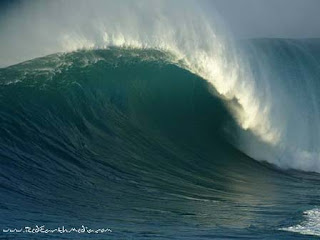Design a blog post on your blog of Maverick waves from different parts of the world. Be sure to describe the geography and the topography of the ocean floor in these areas and how this helps create these massive waves.
"Jaws" is the name given to a big wave surfing reef break on the island of Maui in the U.S. state of Hawaii. It is located on the northern side of the island between mile markers 13 and 14 on the Hana highway and sits at the base of rolling sugar cane field hills. The exact location is represented in the diagram above.
The surf break, a deep water reef break, is called "Jaws" due to the size and ferocity of the waves. The waves at "Jaws" can reach heights of 120 ft (36.6 m) on the face of the wave, moving as fast as 30 mph (48.3 km/h).
The Jaws surf break is the home of tow-in surfing and has reached its worldwide watersports fame largely due to the frequent filming and photography of tow-in surfing legends performing there on enormous ocean waves breaking at the deep reef off the shore; famed big wave surfers such as tow-in surfing pioneers (also known as "The Strapped Crew"-for the rubber straps on their short surfboards to anchor their feet against the forces) notably Laird Hamilton and Dave Kalama.
In order for the surf at "Jaws" to reach its extreme heights, many specific ocean and weather conditions must prevail concurrently. Because ocean swells large enough to produce this kind of surf occur only during winter months, primarily between December and February, they typically coincide with very strong winds which have a large effect on the surf. Other swells, particularly the small but powerful trade wind swells, can make the surf choppy and difficult to ride. There are several other surf spots around the world that boast similar wave heights; however, "Jaws" is famous for its wave forming quality. The reef and rocks at "Jaws" are shaped in a way that magnify incoming swell energy and produce clean and well defined right and left-directional waves with gigantic barreling (hollow, air-filled wave interior) sections
As you can see the Surf Reports go to great detail to ensure surfers have enough information about the break at all times. This can help stay safe in the surf, going out when the winds aren’t at full velocity and staying in when they are. They also provide an extensive long range forecast.
Big Wave Rating | Height | Period | Dir | Wind (Gust) | Weather | |||||||||
Wed 23/02 | 6am | 6.5ft | 11secs |
| 23c | |||||||||
Noon | 6.5ft | 10secs |
| 24c | ||||||||||
6pm | 6ft | 15secs |
| 23c | ||||||||||
Thu 24/02 | 6am | 5.5ft | 9secs |
| 22c | |||||||||
Noon | 5.5ft | 9secs |
| 24c | ||||||||||
6pm | 5.5ft | 8secs |
| 22c | ||||||||||
Fri 25/02 | 6am | 5ft | 8secs |
| 22c | |||||||||
Noon | 5ft | 11secs |
| 24c | ||||||||||
6pm | 5ft | 11secs |
| 23c | ||||||||||
Although this is just a sample, the same table is provided for dates months away which can also give surfers vital information about when it is safe and not safe to surf the break. Generally the higher the wind strength the higher the sets are going to be


No comments:
Post a Comment